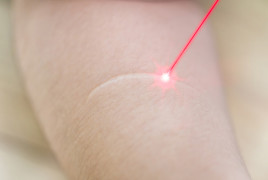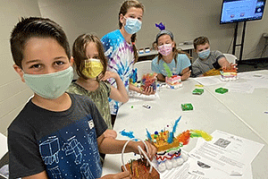Skin cancer types: Squamous cell carcinoma treatment
Squamous cell skin cancer is highly treatable when found early
A board-certified dermatologist can often treat early squamous cell skin cancer in the office.

How do dermatologists diagnose squamous cell skin cancer?
When you see a board-certified dermatologist for a spot that might be skin cancer, your dermatologist will examine your skin carefully.
If your dermatologist finds a spot on your skin that could be any type of skin cancer, your dermatologist will:
Numb the area
Remove a sample from the spot
Doing the above is the only way to know for sure whether you have skin cancer.
Numbing and removing a sample from the spot is a procedure that your dermatologist can perform during your office visit. This procedure is called a skin biopsy. Your dermatologist can perform a skin biopsy while you remain awake.
The skin that your dermatologist removes will be examined under a microscope. Your dermatologist or a doctor who has in-depth experience diagnosing skin growths, such as a dermatopathologist, is best qualified to examine the tissue that your dermatologist removed.
After examining the removed tissue, the doctor writes a report which explains what was seen under the microscope, including whether any skin cancer cells were seen.
If you have squamous cell skin cancer, the report will contain the following information when possible:
Type of squamous cell skin cancer
Whether the cancer has any features that make it aggressive
How do dermatologists treat squamous cell skin cancer?
Most skin cancers are treated with surgical removal of the cancer. Your dermatologist can often perform this type of treatment during an office visit.
The following describes what to expect from surgical removal and other treatments for this skin cancer:
Surgical removal: Three types of surgical removal are used to treat this type of skin cancer. All can be performed during an office visit while you remain awake. This surgery begins with your dermatologist using a local anesthetic to numb the area.
The type of surgical removal you receive will be based on where the skin cancer appears on your body, how deeply the cancer has grown, and other considerations.
Here's what happens during each type of surgical removal used to treat this skin cancer:
Excision: The area to be treated is first numbed. Next, your dermatologist cuts out the tumor along with an area of normal-looking skin. Removing some normal-looking skin helps to get rid of stray cancer cells.
What your dermatologist removes will be looked at under a microscope by a specially trained doctor, such as a dermatopathologist. If the doctor does not see cancer cells in the normal-looking skin, your treatment is complete.
If cancer cells are found in the normal-looking skin, you will need more treatment. Often this means more excision. For some patients, another type of treatment may be more appropriate.Mohs (pronounced moes) surgery: With Mohs surgery, the goal is to remove all the skin cancer cells while keeping as much healthy skin as possible. Mohs is usually performed by a dermatologist who has received specialized training to become a Mohs surgeon.
During the surgery, your Mohs surgeon first removes the squamous cell skin cancer and a thin layer of normal-looking skin around and below it.
While you wait, the removed skin is processed in a lab, and your Mohs surgeon looks at it under a microscope. If cancer cells are seen at any edges, your surgeon will continue to remove very small amounts of skin. This process continues until cancer cells are no longer seen. Most people need stitches and additional wound closure treatment after Mohs.
To learn more about what’s involved in having Mohs surgery and when it’s recommended, go to, What is Mohs surgery?Curettage and electrodesiccation: During this type of surgical removal, your dermatologist first scrapes the tumor from your skin, using a technique called curetting. Next, your dermatologist applies an electrode to destroy remaining cancer cells.
A dermatologist may use this procedure to treat a small squamous cell skin cancer that is classified as a low-risk tumor. Dermatologists generally do not use this surgery to treat skin cancer on the head or neck, or areas of the body where hair grows heavily, such as the scalp, a man’s beard area, or an armpit.
Radiation therapy: If surgical removal alone cannot treat the cancer or you cannot have surgical removal, your treatment plan may include radiation treatments.
The different types of radiation therapy used to treat squamous cell carcinoma are:
Superficial radiation therapy: Beams of radiation are directed just beneath the skin, which treats only the tumor.
External beam radiation therapy: High-energy beams of radiation are sent into the tumor in order to kill cancer cells.
Brachytherapy: Radioactive implants are placed inside (or near) the cancer. Also called internal radiation, this therapy is often used to treat prostate cancer.
Radiation therapy may be given as a second type of treatment when there is a high risk that the cancer will spread. In this case, radiation therapy often follows surgical removal.
If the skin cancer has grown deep or spread, radiation therapy may help a patient feel more comfortable.
Cryosurgery: This treatment involves using an extremely cold substance, such as liquid nitrogen, to destroy the cancer cells. Although seldom used to treat squamous cell skin cancer, cryosurgery can be an option when the cancer is caught early, or a patient is unable to have surgical removal.
Clinical trial: This is a research study. It helps doctors find better treatments for cancer and other diseases. Patients who participate in a clinical trial do so voluntarily. Your dermatologist may recommend that you consider a clinical trial if the treatment could produce the best results for you.
While your dermatologist may recommend a clinical trial, you make the final decision about whether to participate.
Observation: This means that your dermatologist will watch your cancer over time and only consider treatment if the cancer worsens. The decision to observe skin cancer should only be made after considering all the risks and options.
Palliative care: Rather than treating the cancer, this care offers relief from the symptoms or stress of having cancer.
How is advanced squamous cell skin cancer treated?
Advanced means that the cancer has either:
Grown beyond its original location, but not spread to another part of the body
Spread to another part of the body
When this cancer spreads beyond the skin, it travels to the lymph nodes or other organs. Once it spreads, the medical term for the cancer is metastatic.
If you've been diagnosed with advanced squamous cell skin cancer, you will be cared for by a team of medical professionals. This team will include oncologists (cancer doctors). Your treatment plan may include one or more of the following:
Surgery: When surgery can remove the cancer and you’re healthy enough to have surgery, this is often the preferred treatment. After surgery, another treatment, such as radiation therapy or chemotherapy, is often given. Adding another treatment helps to kill any remaining cancer cells.
Radiation therapy: Radiation can target cancer cells in the skin, lymph nodes, or other areas of the body. When a patient has advanced squamous cell skin cancer, radiation therapy is often used along with another treatment.
Immunotherapy: This type of treatment works with your body’s immune system to fight cancer. Immunotherapy helps some people with advanced cancer live longer.
The U.S. Food and Drug Administration (FDA) has approved three immunotherapy medications to treat adults with advanced squamous cell skin cancer:
Cemiplimab-rwlc improves the immune system’s ability to recognize cancer cells, so the immune system can attack the cells more effectively.
In the clinical trials that led the FDA to approve cemiplimab-rwlc, about half the patients who had advanced squamous cell skin cancer had their tumors shrink. In many patients who had tumor shrinkage, the shrinkage lasted for 6 months or longer. A few patients had their tumors disappear completely.
Cemiplimab-rwlc is given by an intravenous (IV) infusion, which is also known as an IV drip. The infusion for cemiplimab-rwlc usually takes about 30 minutes. Most patients go to a hospital or cancer treatment center once every 3 weeks to receive this infusion.
Possible side effects include a rash on the skin, itching, hives, shortness of breath, and dizziness. More serious side effects can occur.Brand name: Libtayo
Patient receiving immunotherapy for advanced squamous cell carcinoma skin cancer
Patients usually receive immunotherapy medication through infusion therapy, which is also called an IV drip.

Pembrolizumab helps your immune system better recognize cancer cells, so it can destroy them. If this medication is prescribed, you would receive an infusion every 3 or 6 weeks, depending upon your needs.
In clinical trials that led the FDA to approve this medication, patients saw their tumors shrink. Some had all signs of cancer disappear.
The most common side effects include fatigue, musculoskeletal pain, some loss of appetite, itch, and diarrhea. More serious side effects can occur.Brand name: Keytruda
Cosibelimab-ipdl can boost the immune’s system’s ability to kill cancer cells.
In the clinical trials that led to FDA approval of this medication, many patients saw their tumors shrink, and a few had no signs of cancer. For most of these patients, the results lasted at least 6 months. For some patients, results lasted a year or longer.
If this medication is prescribed, you will receive infusions, which are given intravenously (IV injected into a vein). For most patients, this infusion takes about 1 hour and is given every 3 weeks.
The most common possible side effects include fatigue, musculoskeletal pain, rash, and diarrhea. More serious side effects can occur.Brand name: Unloxcyt
Like all medications, immunotherapy drugs are not right for every patient. Because immunotherapy medication changes the way your immune system works, some side effects from these medications can be serious.
Your doctor can tell you whether immunotherapy medication may be an option for you. If this is an option, you may receive only immunotherapy medication or be given this medication along with another cancer treatment.
Chemotherapy: This treatment can help slow spreading cancer and relieve symptoms. Sometimes, chemotherapy shrinks tumors.
There are many different chemotherapy drugs. The ones used to treat advanced squamous cell skin cancer are usually given by an IV drip.
Chemotherapy drugs work by killing fast-growing cells in the body. Cancer cells are just one type of cell that grows quickly. Hair cells and cells in your gastrointestinal (GI) tract also grow quickly and can be killed. When chemotherapy kills these cells, patients develop side effects, such as hair loss and nausea.
Other treatments for advanced squamous cell skin cancer: No single treatment is best for everyone who has this advanced cancer. Your medical care team will consider your unique needs. Another type of treatment may be recommended.
What is the outlook for someone who has squamous cell skin cancer?
When found early, this cancer is highly treatable. Left untreated, however, the cancer can spread deep into the skin and travel to other parts of the body, making treatment difficult.
While treatment can remove the cancer, it’s important to know that this cancer can return. You also have a greater risk of developing another skin cancer. That’s why it’s so important to see your dermatologist for routine full-body skin exams.
Find out what else dermatologists recommend after treatment for this cancer at Squamous cell carcinoma: Self-care.
Images
Getty Images
References
Alam M, Armstrong A, et al. “Guidelines of care for the management of cutaneous squamous cell carcinoma.” J Am Acad Dermatol 2018;78:560-78.
Anadolu-Brasie R, Patel AR, et al., “Squamous cell carcinoma of the skin.” In: Nouri K, et al. Skin Cancer. McGraw Hill Medical, China, 2008: 86-114.
Marrazzo G, Zitelli JA, et al. “Clinical outcomes in high-risk squamous cell carcinoma patients treated with Mohs micrographic surgery alone.” J Am Acad Dermatol 2019;80:633-8.
Que SKT, Zwald FO, et al. “Cutaneous squamous cell carcinoma: Management of advanced and high-stage tumors.” J Am Acad Dermatol 2018;78:249-61.
Ribero S, Stucci LS, et al. “Drug therapy of advanced cutaneous squamous cell carcinoma: Is there any evidence?” Curr Opin Oncol. 2017;29(2):129-35.
U.S. Food and Drug Administration:
“FDA approves cemiplimab-rwlc for metastatic or locally advanced cutaneous squamous cell carcinoma.” News release issued 9/28/2018. Last accessed 1/13/2020.
Cemiplimab-rwlc package insert (revised 11/2022). Last accessed 2/3/2025.
Cosibelimab-ipdl package insert (revised 12/2024). Last accessed 2/3/2025.
Pembrolizumab package insert (revised 2/2021). Last accessed 2/3/2025.
Vaidya P, Mehta A, et al. “Concurrent radiation therapy with programmed cell death protein 1 inhibition leads to a complete response in advanced cutaneous squamous cell carcinoma.” JAAD Case Rep. 2019; 5(9): 763–6.
Written by:
Paula Ludmann, MS
Reviewed by:
William Warren Kwan, MD, FAAD
Natalie H. Matthews, MD, FAAD
Rajiv Nijhawan, MD, FAAD
Last updated: 4/2/25
 Atopic dermatitis: More FDA-approved treatments
Atopic dermatitis: More FDA-approved treatments
 Biosimilars: 14 FAQs
Biosimilars: 14 FAQs
 How to trim your nails
How to trim your nails
 Relieve uncontrollably itchy skin
Relieve uncontrollably itchy skin
 Fade dark spots
Fade dark spots
 Untreatable razor bumps or acne?
Untreatable razor bumps or acne?
 Tattoo removal
Tattoo removal
 Scar treatment
Scar treatment
 Free materials to help raise skin cancer awareness
Free materials to help raise skin cancer awareness
 Dermatologist-approved lesson plans, activities you can use
Dermatologist-approved lesson plans, activities you can use
 Find a Dermatologist
Find a Dermatologist
 What is a dermatologist?
What is a dermatologist?